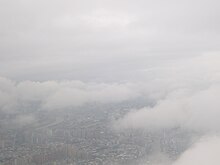Nuclear winter
The nuclear winter is a climatic phenomenon that describes the consequence of the indiscriminate use of atomic bombs. It arose in the context of the cold war, and predicted global cooling due to stratospheric smoke, which would result in a collapse of agriculture and the threat of famine for most of humanity. Although the much-feared holocaust did not occur nuclear, it does seem that there were certain hidden effects produced by the nuclear tests.
The process would follow these steps: The nuclear bomb would kick up a huge cloud of ash and dust that would hang in the atmosphere for months. This layer would hinder or completely prevent the passage of sunlight, which would cause the death of living beings that carry out photosynthesis. These beings, the producers, are the lowest link in the trophic chain or food chain, with which other living beings would also become extinct: herbivores, carnivores and decomposers. In addition, the environment would be unbreathable, so many animals would die directly, not being able to breathe.
The theory arose from a study by Paul J. Crutzen and John Birks in 1982, who already proposed that the massive fires that would result from a global nuclear exchange and the smoke they would generate in the lower layers of the atmosphere would have consequences noteworthy about the weather. Owen B. Toon and Richard P. Turco analyzed the consequences of smoke in the stratosphere and coined the term "nuclear winter" in 1982, while Vladimir Aleksandrov and Gueorgui Stenchikov carried out simulations on more sophisticated models in 1983. Partly as a consequence Out of these studies and others related to it in the late 1980s, Ronald Reagan and Mikhail Gorbachev initiated nuclear disarmament treaties.
In the 2000s, a series of studies were carried out considering the planned reduction of nuclear weapons by the United States and the Soviet Union (the Strategic Offensive Reductions Treaty), and comparing the consequences of a trade within the permitted arsenal due to this context with a limited exchange between minor nuclear powers such as India and Pakistan. In the first case, they accounted for 4,400 nuclear explosions, which would correspond to 440 megatons, 770 million direct victims and 180 Tg (teragrams or trillions of grams) of soot.. In the second, small bombs totaling 0.75 megatons and 44 million direct victims would produce 6.6 Tg of soot. According to this study, even the most modest atomic exchanges would be enough to produce effects of the same order as the little ice age or the year without a summer. The study also suggested that the alteration of the temperature of the stratosphere even in this case could have serious consequences on the flow of gases, and in particular considerable reductions in the ozone layer. The use of the Russian and American arsenal would lead to a decrease temperature comparable to or possibly more pronounced than that of an ice age, perhaps for a decade.
On the other hand, these new calculations based on modern versions of climate models predicted a half-life of soot five times longer than that estimated in the 1980s, which would contribute to aggravating and prolonging the consequences on the climate.
Cooling of the sixties and seventies
It is known that the 1960s and 1970s were somewhat colder globally, and the debate about what caused it is still active. Although it is accepted that there would not be a single cause but that there may be several. In those years, two Russian scientists, Kondratyiev and Nikolsky, hypothesized that atmospheric nuclear tests were somehow affecting the climate on Earth. It was observed that the fireball from a nuclear bomb was capable of heating the air enough to cause nitrogen and oxygen to react and form nitrogen oxides in the upper atmosphere, more specifically in the stratosphere. Although the first atomic bombs (of barely 20 kt) were not capable of reaching these heights, the new thermonuclear devices that emerged in the 1950s could.
It is estimated that for each megaton of energy developed, the fireball ascends between 35 and 40 km and about 3,000 tons of nitrogen oxides (NOx) are produced. If it is taken into account that the troposphere reaches up to 10 km in altitude, it is clear that any hydrogen bomb is capable of contaminating the stratosphere. The fireball generated NOx, which was deposited in the upper layers. Its half-life is about four years. In the two years prior to 1963, the year the Partial Nuclear Test Ban Treaty came into force, the equivalent of 340 Mt was detonated, representing a total of one and a half million tons of NOx suspended between 20 and 50 km high. To this amount we had to add that of the previous tests that still persisted in the atmosphere, which, in total, meant that in 1963 there was the equivalent of 980 Mt detonated in the stratosphere. It does not seem a coincidence that the negative anomalies of 1963, 1964 and 1965 were among the most pronounced in the second half of the century. However, that same year, in Bali, the eruption of Mount Agung took place, but it seems that these effects could only explain half of the cooling produced during those years. The other half would come caused by nuclear tests. Basically it could be summed up in that during those decades the global dimming caused by the emissions of aerosols and reflective gases dominated over the global warming caused by the emissions of greenhouse gases.
There are also studies that have explained this cooling by variations in the solar wind, although it has not been possible to prove that this is the cause or even the main contribution of the cooling of those years.
Contenido relacionado
JavaBean
Subject
Electron transfer (chemistry)


